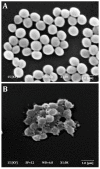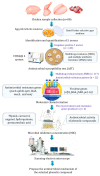Potential of Natural Phenolic Compounds as Antimicrobial Agents against Multidrug-Resistant Staphylococcus aureus in Chicken Meat
- PMID: 37764518
- PMCID: PMC10535414
- DOI: 10.3390/molecules28186742
Potential of Natural Phenolic Compounds as Antimicrobial Agents against Multidrug-Resistant Staphylococcus aureus in Chicken Meat
Abstract
Staphylococcus aureus is one of the most widespread foodborne bacteria that cause high morbidity, mortality, and economic loss, primarily if foodborne diseases are caused by pathogenic and multidrug-resistant (MDR) strains. This study aimed to determine the prevalence of S. aureus in chicken meat in Egyptian markets. Thus, this study might be the first to assess the efficiency of different natural phenolic compounds as novel antibacterial agents against MDR S. aureus pathogens isolated from raw chicken meat in the Egyptian market. The incidence and quantification of pathogenic S. aureus were detected in retail raw chicken meat parts (breast, thigh, fillet, and giblets). In total, 73 out of 80 (91.3%) of the chicken meat parts were contaminated, with S. aureus as the only species isolated. Of the 192 identified S. aureus isolates, 143 were coagulase-positive S. aureus and 117 isolates were MDR (81.8%, 117/143). Twenty-two antibiotic resistance profile patterns were detected. One strain was randomly selected from each pattern to further analyze virulence and resistance genes. Extracted DNA was assessed for the presence of antibiotic-resistance genes, i.e., vancomycin-resistance (vanA), aminoglycosides-resistance (aacA-aphD), apramycin-resistance (apmA), and methicillin-resistance (mecA), penicillin-resistance (blaZ), and virulence genes staphylococcal enterotoxins (sea and seb), Panton-Valentine leucocidin (pvl), clumping factor A (clfA), and toxic shock syndrome toxin (tst). Clustering analyses revealed that six S. aureus strains harbored the most virulence and resistance genes. The activity of hydroquinone was significantly higher than thymol, carvacrol, eugenol, and protocatechuic acid. Therefore, phenolic compounds, particularly hydroquinone, could potentially alternate with conventional antibiotics against the pathogenic MDR S. aureus inhabiting raw chicken meat. Hence, this study indicates that urgent interventions are necessary to improve hygiene for safer meat in Egyptian markets. Moreover, hydroquinone could be a natural phenolic compound for inhibiting foodborne pathogens.
Keywords: Staphylococcus aureus; antimicrobials; chicken meat; foodborne pathogen; multidrug resistance; phenolic compounds.
Conflict of interest statement
The authors declare no conflict of interest.
Figures






Similar articles
-
Efficacy of metal oxide nanoparticles as novel antimicrobial agents against multi-drug and multi-virulent Staphylococcus aureus isolates from retail raw chicken meat and giblets.Int J Food Microbiol. 2021 Apr 16;344:109116. doi: 10.1016/j.ijfoodmicro.2021.109116. Epub 2021 Feb 24. Int J Food Microbiol. 2021. PMID: 33676332
-
Isolation, Virulence, and Antimicrobial Resistance of Methicillin-Resistant Staphylococcus aureus (MRSA) and Methicillin Sensitive Staphylococcus aureus (MSSA) Strains from Oklahoma Retail Poultry Meats.Int J Environ Res Public Health. 2015 May 29;12(6):6148-61. doi: 10.3390/ijerph120606148. Int J Environ Res Public Health. 2015. PMID: 26035662 Free PMC article.
-
Prevalence, multiple antibiotic resistance and virulence profile of methicillin-resistant Staphylococcus aureus (MRSA) in retail poultry meat from Edo, Nigeria.Front Cell Infect Microbiol. 2023 Mar 2;13:1122059. doi: 10.3389/fcimb.2023.1122059. eCollection 2023. Front Cell Infect Microbiol. 2023. PMID: 36936767 Free PMC article.
-
Occurrence and characteristics of methicillin-resistant and -susceptible Staphylococcus aureus and methicillin-resistant coagulase-negative staphylococci from Japanese retail ready-to-eat raw fish.Int J Food Microbiol. 2012 Jun 1;156(3):286-9. doi: 10.1016/j.ijfoodmicro.2012.03.022. Epub 2012 Mar 28. Int J Food Microbiol. 2012. PMID: 22541390
-
A South African Perspective on the Microbiological and Chemical Quality of Meat: Plausible Public Health Implications.Microorganisms. 2023 Oct 3;11(10):2484. doi: 10.3390/microorganisms11102484. Microorganisms. 2023. PMID: 37894142 Free PMC article. Review.
Cited by
-
Prevalence and molecular characterization of multidrug-resistant coagulase negative staphylococci from urban wastewater in Delhi-NCR, India.Arch Microbiol. 2024 Sep 10;206(10):399. doi: 10.1007/s00203-024-04124-y. Arch Microbiol. 2024. PMID: 39254720
-
Extract from Rosa spp. as a Factor Influencing the Growth Rate of Coagulase-Negative Staphylococcus Strains.Molecules. 2025 Mar 24;30(7):1443. doi: 10.3390/molecules30071443. Molecules. 2025. PMID: 40286034 Free PMC article.
-
Green Synthesized Chitosan Nanoparticles for Controlling Multidrug-Resistant mecA- and blaZ-Positive Staphylococcus aureus and aadA1-Positive Escherichia coli.Int J Mol Sci. 2024 Apr 26;25(9):4746. doi: 10.3390/ijms25094746. Int J Mol Sci. 2024. PMID: 38731965 Free PMC article.
-
Antibacterial activity and mechanism of Stevia extract against antibiotic-resistant Escherichia coli by interfering with the permeability of the cell wall and the membrane.Front Microbiol. 2024 Sep 18;15:1397906. doi: 10.3389/fmicb.2024.1397906. eCollection 2024. Front Microbiol. 2024. PMID: 39360325 Free PMC article.
-
Preliminary study on the effects of dry powder and water extract of Neolamarckia cadamba on growth performance, immunity, and intestinal health of yellow-feathered broilers.BMC Vet Res. 2025 Apr 2;21(1):233. doi: 10.1186/s12917-025-04481-w. BMC Vet Res. 2025. PMID: 40170033 Free PMC article.
References
-
- Uyttendaele M., Franz E., Schlüter O. Food Safety, a Global Challenge. Int. J. Environ. Res. Public Health. 2015;13:67. doi: 10.3390/ijerph13010067. - DOI
-
- Lund B.M. Provision of Microbiologically Safe Food for Vulnerable People in Hospitals, Care Homes and in the Community. Food Control. 2019;96:535–547. doi: 10.1016/j.foodcont.2018.09.032. - DOI
-
- Jaffee S., Henson S., Unnevehr L., Grace D., Cassou E. The Safe Food Imperative: Accelerating Progress in Low- and Middle-Income Countries. World Bank Publications; Washington, DC, USA: 2018.
-
- Morshdy A.E.M., Darwish W., Mohammed F.M., Mahmoud A.F.A. Bacteriological Quality of Retailed Chicken Meat Products in Zagazig City, Egypt. J. Adv. Vet. Res. 2023;13:47–51.
MeSH terms
Substances
Grants and funding
LinkOut - more resources
Full Text Sources
Medical

